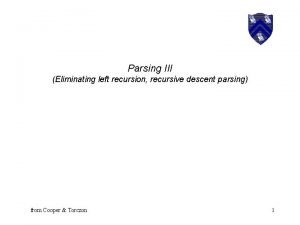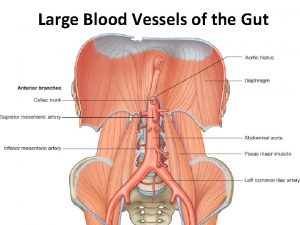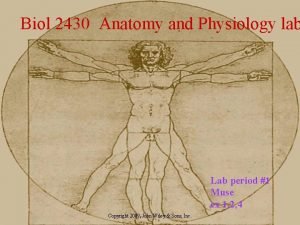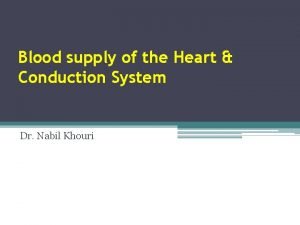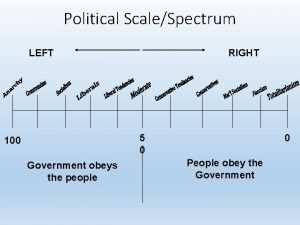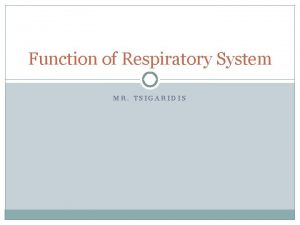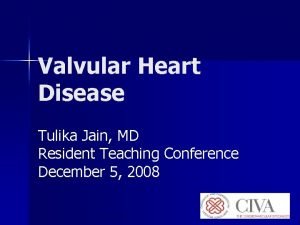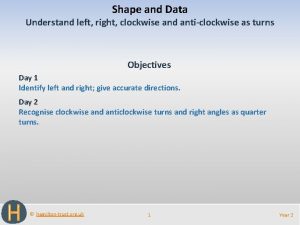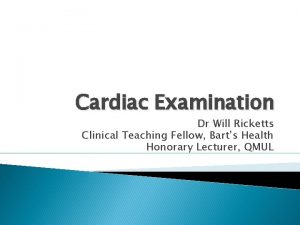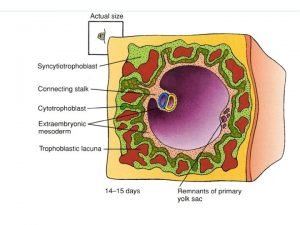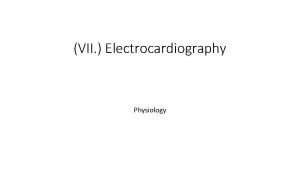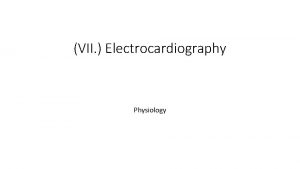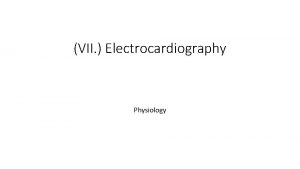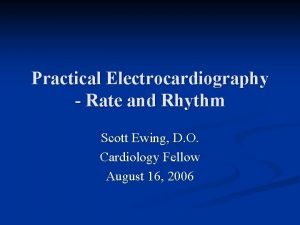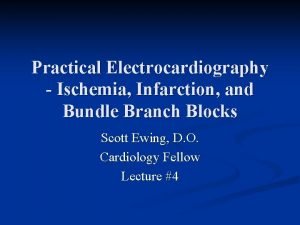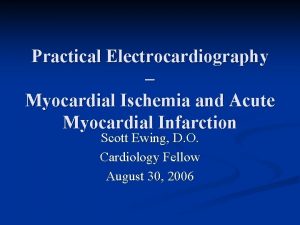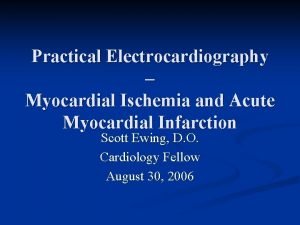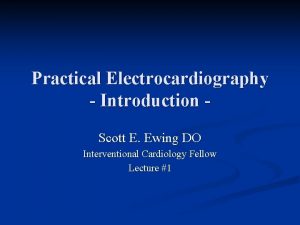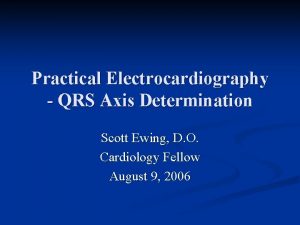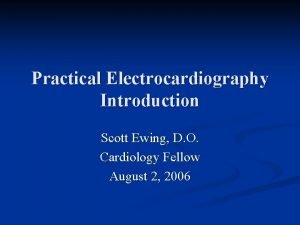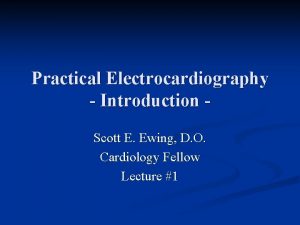Practical Electrocardiography Conditions Affecting the Left and Right




















































- Slides: 52

Practical Electrocardiography – Conditions Affecting the Left and Right Side of the Heart Scott Ewing, D. O. September 21, 2006

Syllabus • • • Introduction Axis Determination Atrial Arrhythmias, Bradycardias, and AV Conduction Block Junctional and Broad Complex Tachycardias Myocardial Ischemia and Acute Myocardial Infarction Conditions Affecting the Left Side of the Heart Conditions Affecting the Right Side of the Heart Conditions Not Primarily Affecting the Heart Exercise Tolerance Testing

Atrial Enlargement

Atrial Enlargement • Causes of chamber enlargement: • • • Volume or diastolic overload Pressure or systolic overload Blood volume increase causes dilation Increase in resistance causes hypertrophy Thinner-walled atrial chambers generally respond to both of these overloads with enlargement EKG evaluation of RAE and LAE facilitated by differing times of electrical activation of the two atria and by the differing directions of the spread of activation

Atrial Enlargement • Right-atrial activation begins first • Proceeds from the SA node in an inferior and anterior direction • Produces the initial deflection of the P wave, which has a positive direction in all leads (except a. VR) • Left-atrial activation begins later • Proceeds from high in the interatrial septum in a left, inferior, and posterior direction • Produces the final deflection of the P wave, which is positive in long-axis lead II but negative in short-axis lead V 1. • • RAE is characterized by an increase in the initial deflection LAE by an increase in the final deflection of the P wave

P Wave Morphology • Schematic representation of atrial depolarization and P wave patterns associated with normal atrial activation and with right and left atrial abnormalities

P Wave Morphology A. B. C. D. Normal Right-atrial enlargement (RAE) Left-atrial enlargement (LAE) Biatrial enlargement (RAE + LAE).

Right Atrial Enlargement

RAE Criteria • • • P wave 2. 5 mm or greater in height, usually lead II P wave often has a sharp, peaked appearance Increased voltage is caused by hypertrophy or acute strain of right atrial tissue Causes COPD, mitral stenosis, mitral regurgitation, or pulmonary emboli RAE is frequently seen in chronic pulmonary disease, the peaked P wave is often called “P pulmonale. ”

Right Atrial Enlargement


Interpretation: RAE • • • P waves have a vertical axis, are 3 mm high in lead II, and have an upright component in lead V 1 of about 3. 5 mm P-wave height in leads II and V 1 indicate the presence of right atrial abnormality (enlargement or hypertrophy) P-wave duration is about 120 ms, but notching is absent and there is no terminal negative component in lead V 1; thus, criteria for left atrial enlargement are not present

Left Atrial Enlargement

LAE Criteria • P wave duration > 0. 11 ms • Remember: long P waves occur because of delay in electrical activation of the enlarged left atrium, as electricity moves leftward from the SA node • • Notched P wave (or “double hump”) with peaks one small box or more apart, best seen in inferior leads Biphasic P wave with the downward portion of the P wave one box or larger in both depth and length, usually lead V 1 (and V 2) LAE often occurs in mitral valve disease (MS or MR) and any cause of LVH Because of this association, a broad notched P wave is often called “P mitrale”

Left Atrial Enlargement


Interpretation: LAE • • P waves are broad and notched (best seen in leads I and II) Duration is about 160 msec Prominent negative component to the P wave in lead V 1, which is about 1 mm deep and about 2 mm wide Broad, notched P waves, together with the prominent negative component in lead V 1, satisfy the criteria for left atrial enlargement

Ventricular Hypertrophy

Ventricular Hypertrophy A. B. • RV and LV changes produced by volume overload Pressure overload Note: hypertrophy / enlargement of the RV or LV is commonly accompanied by enlargement of its corresponding atrium

Left Ventricular Hypertrophy

LVH QRS Morphology • • LVH increases the amplitude of electrical forces directed to the left and posteriorly Repolarization abnormalities can cause ST segment depression and T wave inversion in leads with a prominent R wave ("strain" pattern)

LVH Criteria • Sokolow-Lyon index • SV 1 + (RV 5 or V 6) > 35 mm (3. 5 m. V) • Ra. VL > 11 mm (1. 1 m. V) • Cornell voltage criteria • SV 3 + Ra. VL > 28 mm (2. 8 m. V) (men) • SV 3 + Ra. VL > 20 mm (2. 0 m. V) (women) • Other • • • Leftward axis IVCD (< 120 ms) LAE

61 yo man with SOB and hx of HTN and CHF

Interpretation: LVH • • • SV 1 + RV 5 or V 6 > 35 mm (3. 5 m. V) Presence of LAE Lateral T wave inversions are LVH or could indicate lateral wall ischemia Cardiac enzymes were all negative, SOB was CHF, with pulmonary edema Pt improved with standard therapy

Middle-aged male with chest pain

Interpretation: LVH with AMI • • Classic evolving anterior infarct with loss of R wave progression and ischemic ST-T changes Left axis deviation (consistent with LAFB), QT prolongation (QTc = 0. 49 sec) and LVH: • SV 3 + Ra. VL > 28 mm (2. 8 m. V) (men) • Ra. VL > 11 mm (1. 1 m. V) • QT prolongation likely due to the evolving myocardial infarction pattern with prominent T wave inversions reflecting prolonged ventricular repolarization

Severely ill 67 yo woman

Interpretation: LVH with HTN and Renal Failure • • • LVH and tall, narrow (tented) T waves are most consistent with chronic renal failure causing hypertension and hyperkalemia BUN 42 mg/dl, creatinine 8. 0 mg/dl, potassium 6. 4 m. Eq/L Remember: • • • SV 1 + RV 5 or V 6 > 35 mm (3. 5 m. V) Ra. VL > 11 mm (1. 1 m. V) For men: SV 3 + Ra. VL > 28 mm (2. 8 m. V) For women: SV 3 + Ra. VL > 20 mm (2. 0 m. V) Hyperacute T waves of anterior myocardial infarction (MI) are usually broader and often with a high take-off of the ST segment or J point.

Right Ventricular Hypertrophy

RVH QRS Morphology • • • RVH can shift the QRS vector to the right Usually associated with an R, RS, or q. R complex in lead V 1, especially when due to severe pressure overload T wave inversions may be present in the right precordial leads ("strain" pattern)

RVH Criteria • • R in V 1 ≥ 7 mm (. 7 m. V) q. R in V 1 R/S in V 1 > 1 with R > 5 mm (. 5 m. V) R/S in V 5 or V 6 < 1 S in V 5 or V 6 ≥ 7 mm (. 7 m. V) Right axis deviation RAE

76 yo woman with SOB and hx of severe asthma

Interpretation: RVH • • Tall right precordial R waves and an r. S complex in the left chest leads Tall right precordial R waves (with a q. R complex in lead V 1) and RAD are essentially diagnostic of RVH ST-T changes in V 1 -V 3 are also consistent with RV overload (“RV strain” pattern) RVH occurs over time in response to pressure or volume overload in conditions such as pulmonary hypertension, COPD, pulmonic stenosis, and ASD

Young adult woman with partial anomalous pulmonary venous return, ASD, and severe pulm artery thromboembolic disease

Interpretation: Severe RVH • Classic signs of very marked RVH, usually associated with a severe pressure overload, including: • • • Tall R wave in V 1 Marked right axis deviation T-wave inversions consistent with right ventricular overload ("strain" pattern) • Delayed precordial transition zone with narrow S waves in V 5 and V 6

Combined Abnormalities

85 yo female with asymptomatic bradycardia

Interpretation: Sinus with LAE, LVH and High Grade Block • • • Sinus tachycardia (100 bpm) 3: 1 AV conduction (advanced 2° AV block) Conducting P wave has a prolonged PR interval of 0. 23 second and is constant LAE and LVH IVCD with RBBB and LAFB 3: 1 block with bifascicular block is consistent with severe infranodal disease and is an indication for permanent pacemaker even without overt symptoms

83 yo women with congestive heart failure

Interpretation: Afib with Biventricular Hypertrophy • • • Atrial fibrillation Left ventricular hypertrophy RIGHT axis deviation This should make you think of biventricular hypertrophy (LVH + RVH) With Afib, rheumatic heart disease is most common etiology (mitral stenosis and aortic valve disease in this case)

55 yo woman with dyspnea

Interpretation: RVH with LAE • Left atrial enlargement • Biphasic P in V 1 with broad negative component • Broad P waves elsewhere • Right ventricular hypertrophy • • Tall R in V 1 Vertical or particularly rightward axis LAE combined with of RVH in a dyspneic patient is likely rheumatic mitral valve disease with severe mitral stenosis Remember: LVH usually is associated with LAE, but LAE can stand alone from LVH

86 yo man with slow pulse

Interpretation: Afib with LVH • • • Atrial fibrillation with a slow regularized ventricular response (45/min) Complete heart block with a junctional escape mechanism QRS complexes show IVCD with left axis and LVH Q-T(U) prolongation Etiologic differential diagnosis includes intrinsic conduction disease, rule out drug toxicity or metabolic factors (esp. hyperkalemia) Treatment: If no reversible causes, patient will likely require a ventricular pacemaker, as well as anticoagulation for AF.

The End

Sokolow–Lyon Criteria for LVH • Sokolow–Lyon Criteria for LVH

Cornell Voltage Criteria for LVH • Cornell Voltage Criteria for LVH

Sokolow–Lyon Criteria for RVH • Sokolow–Lyon Criteria for RVH

Butler–Leggett Formula for RVH • Butler–Leggett Formula for RVH

VENTRICULAR ENLARGEMENT • • • (A) - Changes in the sizes of the RV and LV myocardium produced by increases in volume overload caused by regurgitation of some of the already ejected blood (thick upward arrow) back through a leaking outflow valve (thin downward arrow) (B) - Pressure overload caused by obstruction to ejection (thin upward arrow) through a narrowed outflow valve Enlargement of the RV or LV is commonly accompanied by enlargement of its corresponding atrium

Left vs. Right Ventricle • • QRS complex changes typical of ventricular enlargement as they appear in leads I and V 1 No separate criteria for enlargement vs. hypertrophy

Ventricular Enlargement / Hypertrophy A. B. C. D. Normal Left-ventricular enlargement (LVE) Right-ventricular enlargement (RVE) Biventricular enlargement (LVE + RVE).
 Turn around go go go
Turn around go go go Left left right right go go go
Left left right right go go go Right product right place right time right price
Right product right place right time right price Right time right place right quantity right quality
Right time right place right quantity right quality The right man on the right place at the right time
The right man on the right place at the right time Take right
Take right Left recursion and left factoring
Left recursion and left factoring House left vs stage left
House left vs stage left Muscle energy technique
Muscle energy technique You put your right foot in you put your right foot out
You put your right foot in you put your right foot out Short gastric artery
Short gastric artery Staging position
Staging position Stage position names
Stage position names What is stage left and right
What is stage left and right Pleura
Pleura Common hepatic artery
Common hepatic artery Right linear grammar
Right linear grammar Epigastric vs hypogastric
Epigastric vs hypogastric Inferior border of heart
Inferior border of heart Left and right tympanic membrane
Left and right tympanic membrane Gingival margin trimmer uses
Gingival margin trimmer uses Good morning blood
Good morning blood _________________ walk straight and turn (1 نقطة)
_________________ walk straight and turn (1 نقطة) Generador elemental
Generador elemental Diaphram openings
Diaphram openings Thebasian veins
Thebasian veins Virtual bone lab
Virtual bone lab The left and right hand of god
The left and right hand of god Borders of heart
Borders of heart Left and right in french
Left and right in french Pormte
Pormte Realist criminology
Realist criminology Right left scale
Right left scale Transformation of a function
Transformation of a function Pulmonary ventilation consists of two cyclic phases
Pulmonary ventilation consists of two cyclic phases Text that is aligned on the left and jagged on the right
Text that is aligned on the left and jagged on the right Wings of politics
Wings of politics Turn left right here
Turn left right here Tulika jain
Tulika jain 승자트리
승자트리 Answer. go straight turn left turn right
Answer. go straight turn left turn right Rational sequential and analytical strategizing
Rational sequential and analytical strategizing Left right story game for summer
Left right story game for summer What is clockwise and anticlockwise
What is clockwise and anticlockwise Radius periodic table
Radius periodic table Flow diagram in method study
Flow diagram in method study Masonic firing glasses
Masonic firing glasses Look up and to the left
Look up and to the left Quantitative data graphs
Quantitative data graphs The word drama comes from
The word drama comes from Holosystolic murmur
Holosystolic murmur Four areas of auscultation
Four areas of auscultation Left right patterning
Left right patterning






